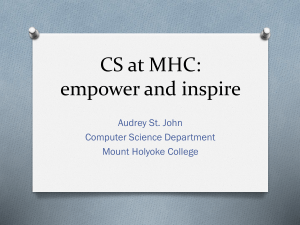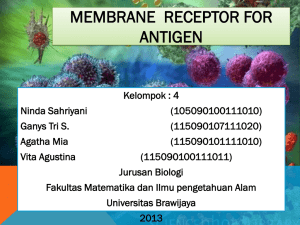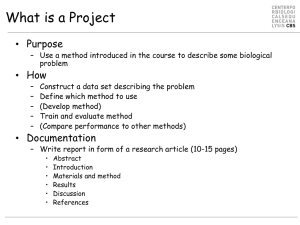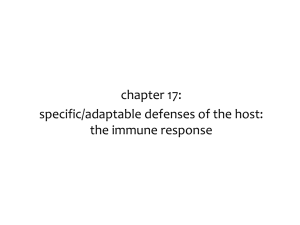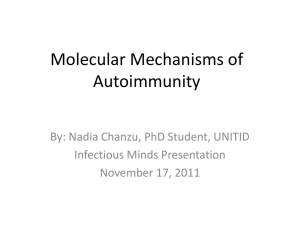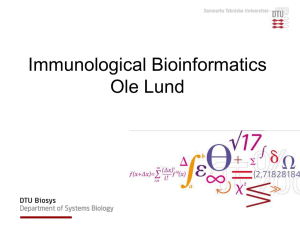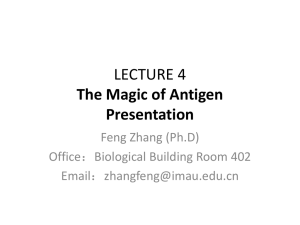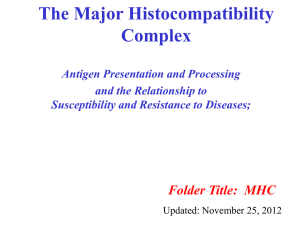Chapter 8
advertisement
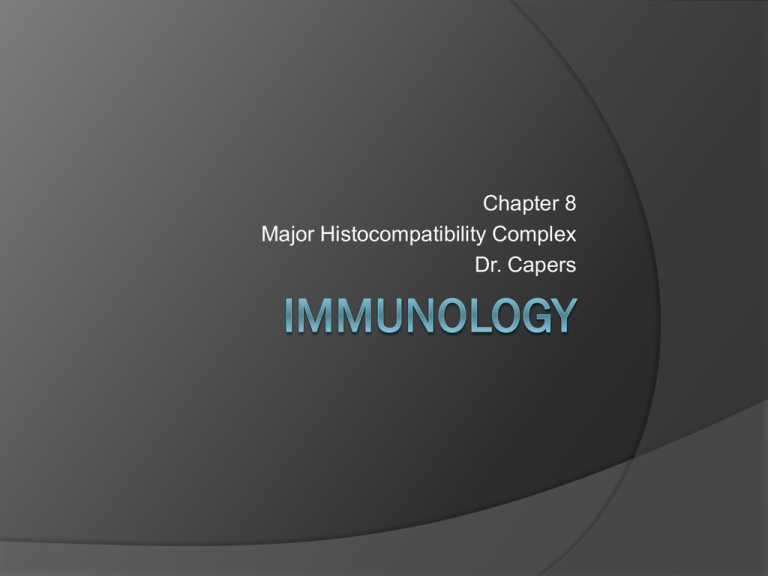
Chapter 8 Major Histocompatibility Complex Dr. Capers Kindt • Goldsby • Osborne Kuby IMMUNOLOGY Sixth Edition Chapter 8 The Major Histocompatibility Complex and Antigen Presentation Copyright © 2007 by W. H. Freeman and Company Antibodies can recognize antigen alone T-cell receptors can only recognize antigen that has been processed and presented by Major Histocompatibility Complex (MHC) Involves: - Antigen processing - Antigen presentation Inheritance of MHC MHC coded by cluster of genes ○ Rejection of foreign tissue is due to immune response against cell surface molecules, histocompatibility antigens Inheritance of MHC Collection of genes on chromosome 6 in humans (HLA complex) and chromosome 17 in mice (H-2 complex) ○ Class I MHC genes - Encode glycoproteins expressed on all nucleated cells ○ Class II MHC genes - Encode glycoproteins expressed on antigenpresenting cells (macrophages, B cells, dendritic cells) ○ Class III MHC genes - Encode various products involved in complement and inflammation Inheritance of MHC Inheritance of MHC Many different alleles exist at each locus among the population ○ Each set of alleles is called a haplotype ○ Genes of MHC lie close together so crossing over during meiosis occurs infrequently ○ Individual inherits one haplotype from mom, one from dad - Many in the population are heterozygous - Alleles are codominant so expressed simultaneously Inheritance of MHC Inbred strains will express identical haplotypes – homozygous ○ Inbred mice are solid colors Inheritance of MHC MHC molecules Both Class I and Class II are membrane-bound glycoproteins ○ Antigen-presenting molecules Class I MHC Alpha α chain ○ Transmembrane ○ Encoded by A, B, and C regions in human MHC complex Beta β2-microglobulin ○ Encoded by highly conserved gene on different chromosome Class II Molecule α1 and α2 chain ○ Transmembrane β1 and β2 chain ○ transmembrane Figure b shows top View of peptide cleft Every individual expresses small number of different Class I and Class II ○ Limited number of MHC must be able to present enormous array of different antigens ○ MHC does not display specificity of Antibodies ○ MHC is “promiscuous” Peptide Interactions with MHC Generation of B-cell receptors (antibodies) and T-cell receptors is dynamic, changing over-time ○ Gene rearrangement In contrast, MHC molecules are fixed in the genes ○ Differences in population due to large number of alleles - In humans, ~370 A alleles, 660 B alleles, 190 C alleles Location of genes Human Class I MHC are red ○ Telomeric end of HLA complex Class II MHC are blue ○ Centromeric end of HLA complex Cellular Expression of MHC MHC Diversity Diversity (polymorphism) helps to protect a species from wide range of infectious diseases Certain alleles make individuals more susceptible to diseases Example, polymorphism in cheetah is limited, due to bottleneck effect MHC Restriction CD8+ Tc cells are MHC Class I restricted Can only recognize antigen presented by MHC Class I molecules Therefore, cells with MHC Class I are called “taget cells”, killed by cytotoxic T cells CD4+ TH cells are MHC Class II restricted Cells with MHC Class II are called antigen- presenting cells (APCs) MHC Restriction Mice immunized with lymphocytic choriomenigitis virus (LCM) Animal’s spleen cells were extracted (containing Tc cells) Antigen Presenting Pathways Cystolic Pathway ○ Endogeneous antigens – produced in cell, in infected cell ○ Antigens presented on MHC Class I to Tc cells Endocytic Pathway ○ Exogeneous antigen – taken in by endocytosis by antigen-presenting cells and presented to TH cells by MHC Class II Cystolic Pathway Endogenous Figure below: ○ (a) shows degradation of misfolded proteing ○ (b) shows intact proteins linked to ubiquitin to be degraded Endocytic Pathway Exogenous
